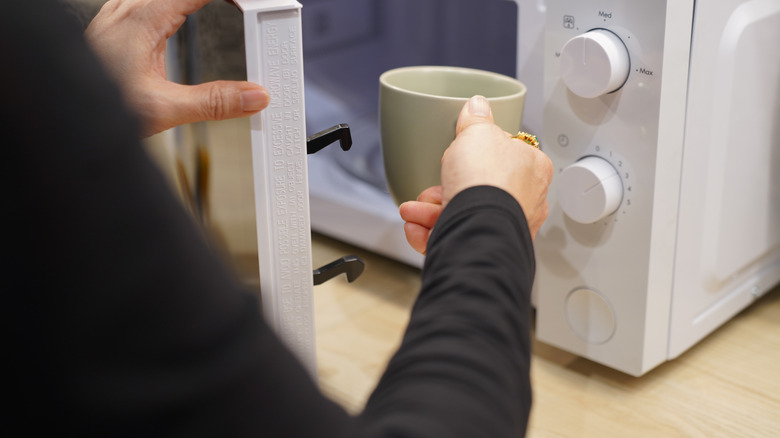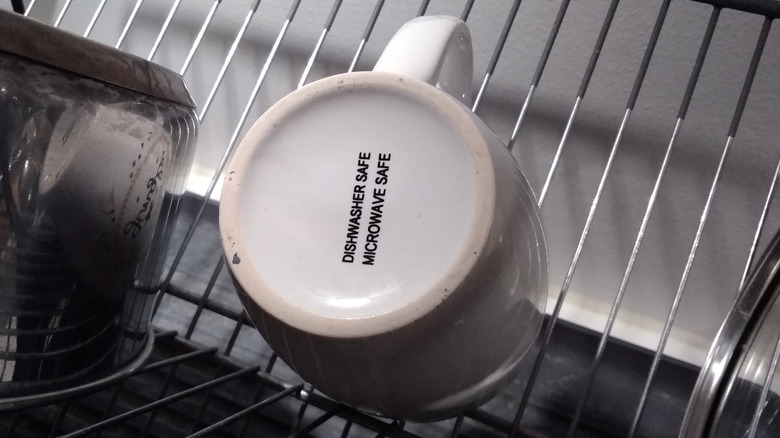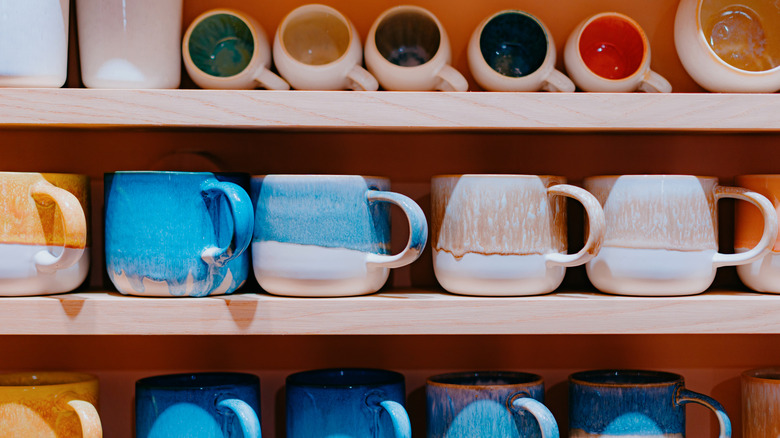How To Tell If Your Mug Is Safe To Microwave
As you stumble into the kitchen at the crack of dawn, you probably think it's a given that you can pop any random mug in the microwave for a steaming cup of courage. After all, aren't mugs specifically made for coffee and tea, and thus largely microwave safe? Not always. Some mugs may get too dangerously hot, possibly even cracking or chipping from the heat, a common mistake you can make with microwaves. Other cups are simply not made for the appliance yet lack a warning label. So, how do you tell if your coffee cup is safe to microwave? Start by checking the bottom for a microwave-safe indicator. You can also consider the material and any decorative elements, such as metal, that may be present.
Microwaving a mug safely isn't only about convenience; it's about your health. Taking the time to check if you have a microwave-safe mug can help save you from the risk of spills caused by an overflow, especially if you heated up that coffee without being fully awake. Not only can mistakenly microwaving the wrong cup result in a too-hot mug or burned fingers, but it may also increase the chances of chemicals leaching into your drink. Here's how to tell and test if your mug is safe for the microwave before you hit that start button in the morning for your hot cup of joe.
Quick ways to determine if your mug is microwave-safe
The bottom of your mug is the best place to look for a clue on whether you can safely microwave it. Your mug may bear a microwave-safe indicator, such as a label with text like "safe for microwave use" or "microwave" written on it. Additionally, a symbol resembling several wavy lines or a box with wavy lines may also indicate that the cup is microwave-safe.
It's also possible you see text warning you to do the opposite, such as "do not use in the microwave," so do heed that advice. Once you know the mug is safe, best practices are to not "nuke" it but instead heat it in 20- or 30-second intervals until warm. This will ensure that it heats evenly and resists cracking from extreme temperatures over time. You should also never microwave an empty mug, as the mug (rather than a liquid) will absorb the heat, causing it to potentially shatter.
You can also conduct a quick test to ensure that your mug is microwave-safe. Fill it with water, then microwave for just 1 minute. Once finished, pay attention to the handle. If it gets too hot to comfortably hold, it's a warning sign that your material absorbs too much heat; keep it away from the microwave. The same applies if the mug begins to crack or chip, as it clearly cannot handle the pressure of repeated (hot) use. This test can also help you decide whether it's safe to use second-hand drinkware if it is absent a label.
Mug material determines whether it's safe to microwave
Chances are, you have a mug or two in your cabinet without any label. While the water heating test will help, the material can also provide a clue. Mugs made of ceramic and glass can typically undergo heating safely without worry. However, you should pay attention to any decorative details present before putting these household items in your microwave. Glitter and other metallic accents can cause a spark as the electrons bounce around during the heating process, potentially even risking a fire. If your favorite Disney mug is speckled with glitter and you want to sip out of it, then heat your beverage in a suitable container first before pouring it into the mug.
You likely have an assortment of perfectly safe mugs, but you may have several you should avoid heating up. Plastic drink containers, even those marked microwave-safe, should be avoided. Some plastic is manufactured with Bisphenol A (BPA), and the appliance's heat could release the chemical into your beverage. Whether it's an old Garfield cup from the thrift shop, weathered plastic from a favorite tourist attraction, or just one of those viral vintage rainbow mugs, you should err on the side of caution and keep your older pieces away from the microwave. Even if made of ceramic, many drinkware items, either homemade or manufactured before 1992, contain lead-based glazes, which may leach into your drink. Since it may be difficult to know the materials, particularly in vintage or artisan pieces, consider using it as storage or repurposing your mugs in other ways around the house.


